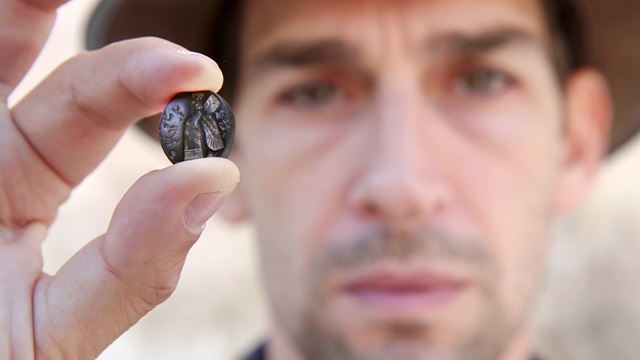Rom Navot, Excavation Director on behalf of the Israel Antiquities Authority, with the rare seal. Photo Emil Aladjem, Israel Antiquities Authority. A remarkably rare and unique stone seal from the , dating back approximately 2,700 years, was unearthed near the Southern Wall of the Temple Mount in the Davidson Garden during excavations conducted by the Israel Antiquities Authority and the City of David organization.
The seal features a name inscribed in paleo-Hebrew script and a winged figure. The object, which was engraved with mirror writing, served as both an amulet and a tool for legally signing documents and certificates. It has a convex cut on each side and a hole drilled through its length, allowing it to be strung onto a chain and worn around the neck.

In its center, a figure is depicted in profile, possibly a king, with wings. The figure is wearing a long, striped shirt and striding towards the right. It has a mane of long curls covering the nape of the neck and is adorned with a hat or crown.
The figure raises one arm forward with an open palm, perhaps suggesting an object it is holding. On both sides of the figure, an inscription is engraved in paleo-Hebrew script: “LeYehoʼezer ben Hoshʼayahu.” According to Dr.
Yuval Baruch and Navot Rom, excavation directors on behalf of the Israel Antiquities Authority, “The seal, made of black stone, is one of the most beautiful ever discovered in excavations in ancient Jerusalem, and is executed at the highest artistic level.” According to Israel Antiquities Authority Archaeologist and Assyriologist Dr. Filip Vukosavović, who studied the seal, “This is an extremely rare and unusual discovery.
This is the first time that a winged ‘genie’ – a protective magical figure – has been found in Israeli and regional archaeology. Figures of winged demons are known in the Neo-Assyrian art of the 9th-7th Centuries BCE, and they were considered a kind of protective demon.” The researchers believe that the object, upon which originally the demon image alone appeared, was worn as an amulet around the neck of a man named Hoshʼayahu, who held a senior position in the Kingdom of Judah’s administration.
By virtue of his authority and status, this Hoshʼayahu allowed himself to ennoble himself and flaunt a seal with an awe-inspiring figure engraved on it – one embodying a symbol of authority. “It seems that the object was made by a local craftsman – a Judahite, who produced the amulet at the owner’s request. It was prepared at a very high artistic level,” says Dr.
Vukosavović. The hypothesis is that upon Hoshʼayahu’s passing, his son Yehoʼezer inherited the seal, and then added his name and his father’s name on either side of the demon. This he did, perhaps, to directly appropriate to himself the beneficial qualities he believed the talisman embodied as a magical item.
The name Yehoʼezer is familiar to us from the Bible (Chron. I 12:7) in its abbreviated form – Yoʼezer, one of King David’s fighters. Also, in the book of Jeremiah (43:2), describing the events of this very period, a person is mentioned with a parallel name, ʼAzariah ben Hoshʼaya.
The two parts of his first name are written in reverse order to the seal owner’s name, and his second name is the same, appearing in its abbreviated form. This writing form in the text fits the name on the newly discovered seal and it is thus appropriate for this time period..



















